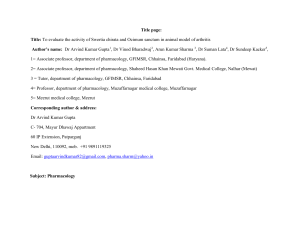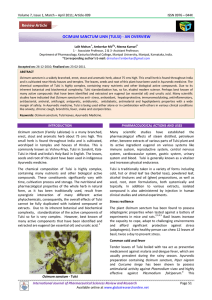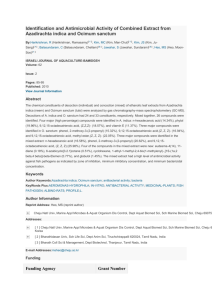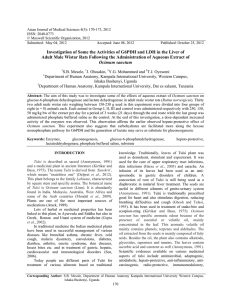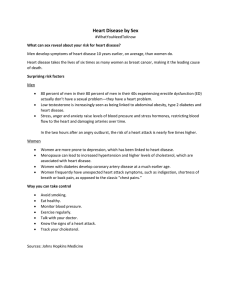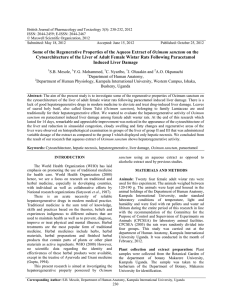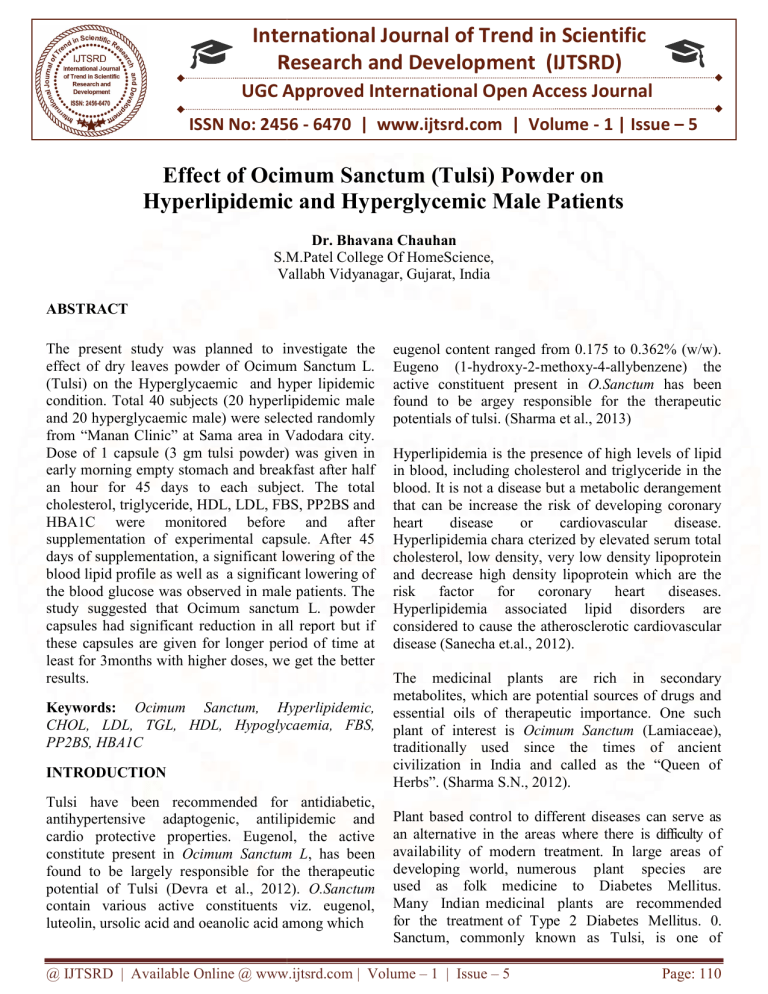
International Journal of Trend in Scientific
Research and Development (IJTSRD)
UGC Approved International Open Access Journal
ISSN No: 2456 - 6470 | www.ijtsrd.com | Volume - 1 | Issue – 5
Effect of Ocimum Sanctum (Tulsi) Powder on
Hyperlipidemic and Hyperglycemic Male Patients
Dr. Bhavana Chauhan
S.M.Patel College Of HomeScience,
Vallabh Vidyanagar
Vidyanagar, Gujarat, India
ABSTRACT
The present study was planned to investigate the
effect of dry leaves powder of Ocimum Sanctum L.
(Tulsi) on the Hyperglycaemic and hyper lipidemic
condition. Total 40 subjects (20 hyperlipidemic male
and 20 hyperglycaemic male) were selected randomly
from “Manan
anan Clinic” at Sama area in Vadodara city.
Dose of 1 capsule (3 gm tulsi powder) was given in
early morning empty stomach and breakfast after half
an hour for 45 days to each subject. The total
cholesterol, triglyceride, HDL, LDL, FBS, PP2BS and
HBA1C weree monitored before and after
supplementation of experimental capsule. After 45
days of supplementation, a significant lowering of the
blood lipid profile as well as a significant lowering of
the blood glucose was observed in male patients. The
study suggested
sted that Ocimum sanctum L. powder
capsules had significant reduction in all report but if
these capsules are given for longer period of time at
least for 3months with higher doses, we get the better
results.
Keywords: Ocimum Sanctum, Hyperlipidemic,
CHOL, LDL, TGL, HDL, Hypoglycaemia, FBS,
PP2BS, HBA1C
INTRODUCTION
Tulsi have been recommended for antidiabetic,
antihypertensive adaptogenic, antilipidemic and
cardio protective properties. Eugenol, the active
constitute present in Ocimum Sanctum L
L, has been
found to be largely responsible for the therapeutic
potential of Tulsi (Devra et al., 2012). O.Sanctum
contain various active constituents viz. eugenol,
luteolin, ursolic acid and oeanolic acid among which
eugenol content ranged from 0.175 to 0.362% (w/w).
Eugeno (1-hydroxy-2-methoxy
methoxy-4-allybenzene) the
active constituent present in O.Sanctum has been
found to be argey responsible for the therapeutic
potentials of tulsi. (Sharma et al., 2013)
Hyperlipidemia is the presence of high levels of lipid
in blood, including cholesterol and triglyceride in the
blood. It is not a disease but a metabolic derangement
that can be increase the risk of developing coronary
heart
disease
or
cardiovascular
disease.
Hyperlipidemia chara cterized by elevated serum total
cholesterol, low density, very low density lipoprotein
and decrease high density lipoprotein which are the
risk
factor
for
coronary
heart
diseases.
Hyperlipidemia associated lipid disorders are
considered to cause the atherosclerotic cardiovascular
disease (Sanecha et.al., 2012).
The medicinal plants are rich in secondary
metabolites, which are potential sources of drugs and
essential oils of therapeutic importance. One such
plant of interest is Ocimum Sanctum (Lamiaceae),
traditionally used since the times of ancient
civilization in India and called as the “Queen of
Herbs”. (Sharma S.N., 2012).
Plant based control to differeent diseases can serve as
an alternative in the areas where
here there is difficulty of
ment. In large areas of
availability of modern treatm
developing world, numerouss plant species are
used as folk medicine to
t Diabetes Mellitus.
Many Indian medicinal plaants are recommended
for the treatment of Type 2 Diabetes Mellitus. 0.
Sanctum, commonly known
n as Tulsi, is one of
@ IJTSRD | Available Online @ www.ijtsrd.com | Volume – 1 | Issue – 5
Page: 110
International Journal of Trend in Scientific Research and Development (IJTSRD) ISSN: 2456-6470
the plants that have long been used in traditional
herbal medicine against Diabetes (Asolkar et al.,
1992, Marles and Famsworth, 1995, Prajapati et al.,
2003). However, only few scientific attempts have
been made to correlate scientifically.
Hyperglycemia or high blood sugar is a condition
in which an excessive amount of glucose circulates in
the blood plasma. Diabetes Mellitus is the most
common pathological condition that presents with
hyperglycemia. Diabetes Mellitus is one of the most
common metabolic disorders. It is one of the leading
causes of morbidity worldwide. Diabetes mellitus is
characterized by chronic hyperglycemia with
disturbances of carbohydrate, fat and protein
metabolism resulting from defects in insulin
secretion, insulin action or both. Diabetes mellitus
usually presents with its characteristic symptoms
such as thirst, polyuria, blurring of vision, weight
loss and polyphagia. Sometimes its acute
complications like keto-acidosis or nonketotic
hyperosmolarity may be the first presentation. These
complications in the absence of timely treatment may
lead to death. (Shaw et al., 2010)
MATERIALS AND METHODS
Study Population: The patients who visited
“MANAN” clinic were included in the study. A total
of 40 patients (45 to 55 years of age) were selected
for the study. A Randomised control trial conducted
in the “MANAN” clinic, Vadodara. The study
included 20 h y p e r l i p i d e m i c male and 20
h yper gl ycaem ic m ale pati ents..
Ethical Clearance: The study was performed under
the supervision of the Physicians. All the Procedure
was informed to the patient in his native language.
After taking their consent the subjects were enrolled
and interviewed at their convenient timing to fill
questionnaire which is prepared for research.
Preparation and Feeding of Tulsi Leaf powder:
Good quality of Tulsi leaves were purchased from
local market. Wash Tulsi leaves thoroughly with
distilled water. Pressed leaves between folds of
tissue paper and dry at a room temperature for 35 days. The dry leaves ground to very fine powder
in a mixer, Sap green colour powder were obtained.
These Sap green colour powder were weighted in 3
gm each and fill in a capsule. These capsules were
packed in a dry small plastic bag and seal it. Each
plastic bag contains 45 capsules. The biochemical
profile like total cholesterol, triglyceride, HDL, LDL,
FBS, PP2bS, and HbA1c were estimated at
beginning and end of the intervention study. After
that t test and z test were used to test the
significance of mean difference
between
preliminary and final value of biochemical
parameters.
Feeding of the Subjects: In this study tulsi powder
capsule were given to the selected subjects per
day in empty stomach and after 30 minute they
consume their breakfast. Subjects consume this
capsule for 45 days but they continued their all
regular medicines that is prescribed by doctor and do
not change their regular dietary pattern
Initial Assessment: The patients diagnosed as type
2 diabetes mellitus by physician of the clinic
underwent physical examination. The physical
examination consisted of assessment of the
parameters like Height, weight, Body mass Index,
Waist circumference, Hip circumference, blood
pressure of extremities. Information
related to
pharmacological treatment (0ral hypoglycaemic
agents, Insulin), pre-existing health or diabetic
complications, smoking status as well as
demographic information was also recorded at the
initial assessment.
Laboratory investigations: Blood samples (3-5
ml) were drawn from each patient by
venepuncture through plastic disposable syringes.
The blood samples were collected in a clean oven
dried glass bottles All Laboratory investigations were
conducted at central research laboratory using the set
protocol and procedures established by the hospital.
The total cholesterol using Glaxo India Ltd’ s
enzymatic kit, triglycerides using Glaxo India Ltd’s
enzymatic kit. In the serum, low-density lipoprotein
(LDL)-cholesterol and very low-density lipoprotein
(VLDL)-cholesterol was precipitated by the addition
of phosphor tungstic acid and magnesium chloride.
The supernatant obtained was used for the
determination of high-density lipoprotein (HDL)cholesterol using Glaxo India Ltd’s enzymatic kit. For
FBS and PP2BS they use GOD & POD (glucose
oxidase- pe roxidase) method & for HBA1C the
use enzymatic assay method.
@ IJTSRD | Available Online @ www.ijtsrd.com | Volume – 1 | Issue – 5
Page: 111
International Journal of Trend in Scientific Research and Development (IJTSRD) ISSN: 2456-6470
RESULTS
Effect of Tulsi leveas (O. Sanctum) on Male
hyperlipidemic experimental group
In Male experimental group the T.CHOL decreases
from 163.85 ± 41.44 to 148.55 ± 43.05 and it was
insignificant at level of ≤0.05 and ≤0.01 (Fig-1). 5
male subjects were having noemal total cholesterol
level i.e. < 200 mg/dl. The TGL decreases from 165.9
± 137 to 140.05 ± 114.5 and it was insignificant at
level of ≤0.05 and ≤0.01 (Fig-2). 12 subjects had
normal triglyceride level i.e. < 150 mg/dl. The LDL
decreases from 97.45 ± 40.8 to 84.2 ± 40.6 and it was
insignificant at level of ≤0.05 and ≤0.01 (Fig-3). 11
had normal LDL level < 100 mg/dl. The HDL level
was very slightly increases from 44.75 ± 13.01 to 47.4
± 13.02 and it was not significant at as p-value(0.144)
viz. ≤0.05 and ≤0.01. Only 4 subjects were under the
normal HDL level i.e. < 40 mg/dl. So we can
conclude that there is no significant variation between
pre-data mean and post-data mean (Fig-4)
Male Cholesterol (mg/dl)
300
200
100
0
1
2
3
4
5
6
7
8
9 10 11 12 13 14 15 16 17 18 19 20
Pre
Post
Figure 1: Comparison of Pre And Post Data of Male Cholesterol
800
Male Triglyceride (mg/dl)
600
400
200
0
1
2
3
4
5
6
7
8
9 10 11 12 13 14 15 16 17 18 19 20
Pre
Post
Figure 2: Comparison of Pre and Post Data of Male Tryglyceride
@ IJTSRD | Available Online @ www.ijtsrd.com | Volume – 1 | Issue – 5
Page: 112
International Journal of Trend in Scientific Research and Development (IJTSRD) ISSN: 2456-6470
2456
200
Male LDL (mg/dl)
150
100
50
0
1
2
3
4
5
6
7
8
9 10 11 12 13 14 15 16 17 18 19 20
Pre
Post
Figure 3: Comparison of Pre And Post Data Of Male LDL
100
Male HDL (mg/dl)
80
60
40
20
0
1 2 3 4 5 6 7 8 9 10 11 12 13 14 15 16 17 18 19 20
Pre
Post
Figure 4: Comparison Of Pre And Post Data Of Male HDL
Effect of Tulsi leveas (O. Sanctum)) on Male hyperglycaemic experimental group
The FBS in the male experimental grroup improve from the value of 388.67 ± 13.4 to 368.5 ± 17.9 and it
was significant at <0.05, <0.01 level respectively. (Fig. 5) The PP2BS in the male
ma experimental group
improve from the value of 610.3 ± 46.8 to 515.9 ± 33.3 and it was significant at <0.05, <0.01 level
respectively. (Fig. 6) The HBA1C inn the male experimental group slightly change from 39.03 ± 0.55 to
t. More changes were not seen in pre and post report of HBA1C due
38.72 ± 0.79 and it was insignificant.
to limitation of study period of inteervention. As it was only 45 days but HBA1
1C gives us 3 months
average blood glucose level so not muuch change observed. (Fig. 7)
Figure 5: Comparison o Pre And Post Data Of Male FBS
@ IJTSRD | Available Online @ www.ijtsrd.com | Volume – 1 | Issue – 5
Page: 113
International Journal of Trend in Scientific Research and Development (IJTSRD) ISSN: 2456-6470
2456
Figure 6: Comparison of Pre And Post Data of Male PP2BS
Figure 7: Comparison of Pre And Post Data Of Male HBA1C
DISCUSION
In the traditional system of Indian medicine different
parts of Tulsi have been recommended for anti
diabetic, antihypertensive adaptogenic, antilipidemic,
cardio protective and so on properties. In this study
after analysing data we conclude that Ocimum
sanctum L.. powder capsules had significant reduction
in all report but giving these capsules for longer
period of time (3 months), we get better results. We
can also increase the dosage per day for better results.
Similar study conducted by Rai et al., 1997
1997. Tulsi
powder supplementation for a period of 1 month
registered a slight increase in the blood sugar and
lipid levels of the controls. A significant reduction
was also noticed in the levels of total cholesterol,
LDL-cholesterol, VLDL-cholesterol
cholesterol and tri
triglycerides
after supplementation with tulasi powder. No
appreciable change was noticed in the HDL
HDLcholesterol. In addition to the blood glucose and lipid
levels, the total amino acids and uronic acid also
exhibited a significant reduction after 30 days of tulasi
supplementation. Similar study conducted by Sharma
and Paul, 2011. When Ocimum Sanctum leaves were
administered to DHR group, a significant
hypoglycemic and antihyperlipidemic effect was
observed with reduced levels of LDL, cholesterol and
TGL and
d marginally increased HDL levels. Same
result was obtained by Mondal et.al., 2012, that few
individual who had an apparently normal medical
history had high cholesterol and triglycerides levels. It
was observed that there was a significant decrease in
the elevated levels of cholesterol of these individuals.
The study conducted by Som
masundaram G (2012)
for 90 days after 90 days shows
s
that significant
drop in the mean FBS level from 174.35 mg/dl to
114.50 mg/dl. In PP2BS afteer 90 days shows that
significant drop in the mea
ean PP2BS level from
247.31 mg/dl to 152.02 mg/d
dl and In HBA1C after
90 days shows that significa
ficant drop in the mean
HBA1C level. Furthermore the results correlate
with all the preclinical stud
dies reported that who
used aqueous and alcoholic extract
e
of O. Sanctum
@ IJTSRD | Available Online @ www.ijtsrd.com | Volume – 1 | Issue – 5
Page: 114
International Journal of Trend in Scientific Research and Development (IJTSRD) ISSN: 2456-6470
in rat models showed significant decrease in the
levels of
blood glucose and glycosylated
haemoglobin.(Narendhikaran R.T., 2006) Mitra
A. (2007) suggests that tulsi leaves shows
significant improvement in several biochemical
parameters.
Thus
the
composite
shows
hypoglycemic effect as being revealed by the
reduction of fasting blood sugar level from 154
±6 to 139±8 (p=0.020). Khogare et.al ( 2 0 1 1 )
also observed there was a significant fall in the
levels of blood glucose when alloxan induced
diabetic respondents was treated with tulasi level
extract for 30 days and study reveals that tulasi has
anti hyperglycemic action.
Suanarunsawat T. (2014) study conclude that
treatment of AQOS (aqueous extracts of Ocimum
sanctum L.) for three weeks significantly lowered
blood glucose in DM rats.. Agrawal R. (2012)
conclude that the significant fall in fasting blood
sugar and HbA1C may be attributed to the
hypoglycemic effect of Tulsi. Other studies
conducted that after intervention of Tulsi leaves
blood sugar level were decreased. (Dwividendra
Kumar et al., 2013, Srinivas P., 2014, and JMS
Hannan, 2015).
CONCLUSION
The study concludes that Ocimum Sanctum L. (Tulsi)
powder supplementation to hyperlipidemic and
hyperglycaemic patients gave very effective reduction
in their lipid profile and blood glucose level. If the
supplementation amount and period will be increased
up to 3 months we may get the better result.
REFERENCES:
1) Agrawal R.. (2012) Effect of Tulsi (Ocimum
sanctum Linn) on clinical and biochemical
parameters of metabolic syndrome, Journal of
Natural Remedies, 12(1), 63-67
2) Asolkar L.V., Kakkar K.K., Chakre O.J. (1992)
Second supplement to glossary of Indian
Medicinal, Plants with active principals, Part I &
Part II, New Delhi: CSRI.
3) Devra D.K., Mathur K.C., Agarwal R.P.,
Indrabhadu, Goyal S. and Agarwal V. (2012),
"Effect of Tulsi (Ocimum Sanctum Linn.) on
clinical and biochemical parameters of metabolic
syndrom", Journal of Natural Remedies, 12(1),
63-67.
4) Dwividendra Kumar Nim ( 2 0 1 3 ) Clinical
evaluation of anti-hyperglycemic activity of
diffusa and Ocimum sanctum
Boerhaavia
extracts in streptozocin induced T2DM rat
models, Int J Pharm Biomed Sci., 4(1), 30-34
5) Hannan J.M.A. (2015) Actions Underlying
Antidiabetic Effects of Ocimum sanctum Leaf
Extracts in Animal Models of Type 1 and
Type 2 Diabetes, European Journal of
Medicinal Plants 5(1): 1-12.
6) Khogare D.T. and Lokhande S.M. (2011) Effect
of Tulsi (Ocimum Sanctum) on Diabetes
mellitus, Indian Streams Research Journal Vol.
1(II), 189-191
7) Marles .J., Farnsworth N.R. (1995) Antidiabetic
plants
and
their
active constituents.
Phytomedicine 2, 137-189.
8) Mondal S., Mirdha B.R., Pathi M.M. and
Mahapatra S.C. (2012), “Dried leaf extract of
Tulsi
(Ocimum sanctum Linn) reduces
cardiovascular disease risk factors: Results of a
double blinded randomized controlled trial in
healthy volunteers”, Journal of Preventive
Cardiology,1(4), 177-181.
9) Narendhikaran R.T. (2006)
Biochemical
evaluation of antidiabetogenic properties of
some commonly used Indian plants on
streptozotocin induced diabetes in experimental
rats. Clinical and Experimental Pharmacology and
Physiology, 33(12), 1150-1157.
10) Prajapati N.D., Purohit S.S., Sharma A.K.,
Kumar T.A. (2003) Handbook of Medicinal
Plant- A complete source book. Agrobius
(India).Jodhpur: Shyam.
11) Rai V, Iyer Uma and Mani U. (1997), "Effect of
Tulasi (Ocimum Sanctum) leaf powder
supplementation on blood sugar levels, serum
lipids and tissue lipids in diabetic rats”, Plant
Foods Hum Nutr, 50(1), 9-16.
12) Sanecha C., Sharma P. K., D'Sauza U. P. and
@ IJTSRD | Available Online @ www.ijtsrd.com | Volume – 1 | Issue – 5
Page: 115
International Journal of Trend in Scientific Research and Development (IJTSRD) ISSN: 2456-6470
Shastry C.S. (2012) “Anticholesteremic and
Antilipidemic activity of Stem bark extracts of
Moringa olefera in Diet induced hyperlipidemia
model in rats”, International Journal of
pharmaceutical and chemical
sciences, 1 (3),
916 – 923
13) Sharma Nidhi, Sharma Preeti, Jasuja Nakuleshwar
and
Joshi
Sureshchand
(2013),
"Hypocholesterolemic
and
antioxidant
potentials of some plants and herbs", Research
and Reviews, Journal of Zoological Sciences,
1(2), 26-42.
14) Sharma S.N. (2012), “A mine of medicinal uses:
Ocimum
Sanctum
the
holy
basil",
International Journal of Pharmacy Review
and Research, 2(2), 69-74.
15) Sharma Vikram and Paul Arindum (2011), "The
effect of fresh Ocimum Sanctum Linn (Tulsi)
leaves on wound healing in non-diabetic and
diabetic hyperlipidemic diabetic rats", Asian
Journal of Biochemical and Pharmaceutical
Research , 3(1), 399-404.
16) Shaw J.E., Sicree R.A., Zimmet P.Z. (2010)
Global estimates of the prevalence of diabetes for
2010 and 2030. Diabetes Res Clin Pract 87, 4
17) Somasundaram G. (2012) Evaluation of the
Antidiabetic effect of Ocimum sanctum in type 2
Diabetes Patients, International journal of Life
science & Pharma Research, 2(3)
18) Srinivasa Prasadacharyulu (2014) Leaves of
Potent
Ocimum
Sanctum
[LOS]:
A
Antidiabetic Herbal Medicine. ijird, Vol 3(4)
19) Suanarunsawat T. (2014) Anti-Oxidative, AntiHyperglycemic and Lipid-Lowering Effects
of Aqueous Extracts of Ocimum sanctum L
Leaves in Diabetic Rats, Food and
Nutrition
Sciences, 5, 801-811
@ IJTSRD | Available Online @ www.ijtsrd.com | Volume – 1 | Issue – 5
Page: 116

